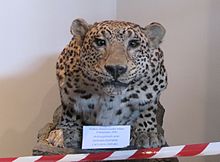Anatolian leopard
| Anatolian leopard | |
|---|---|
 |
|
| Scientific classification | |
| Kingdom: | Animalia |
| Phylum: | Chordata |
| Class: | Mammalia |
| Order: | Carnivora |
| Family: | Felidae |
| Genus: | Panthera |
| Species: | Panthera pardus |
| Subspecies: | P. p. tulliana |
| Trinomial name | |
|
Panthera pardus tulliana (Valenciennes, 1856) |
|
The Anatolian leopard (Panthera pardus tulliana), also called the Asia Minor leopard, was proposed in the 19th century as a distinct leopard subspecies native to south-western Turkey. Based on morphological analysis, it was proposed to retain the name 'Anatolian leopard' for the population that lived in south-western Turkey, where leopards are considered extinct since the mid-1970s. To date, no leopard has been recorded in this area.
The first camera trap photograph of a leopard in Turkey was obtained in September 2013 in the Trabzon Province. In November 2013, a leopard was killed in the Çınar district of Diyarbakır Province. This specimen is considered the western-most observation of a Persian leopard.
The Anatolian leopard was first described on the basis of a skin of a leopard that was shot in the extreme west of Asia Minor, near Izmir in Turkey. Anatolian leopards are thought to have ranged in the Aegean and western parts of Turkey but were not known to be present in the Black Sea region.
Since surveys were not carried out in western Turkey until the mid 1980s, biologists doubted whether leopards still survived in this part of Anatolia. Sighting reports from the environs of Alanya in the south of the Lycian peninsula suggested that a scattered population existed between Finike, Antalya and Alanya in the early 1990s. Fresh faecal pellets found in Termessos National Park in 1992 were attributed to an Anatolian leopard. A decade later, no signs of the presence of leopards were detected in the Termessos National Park. Interviews conducted with local people and national park personnel did not corroborate the presence of leopards in this area.
...
Wikipedia
